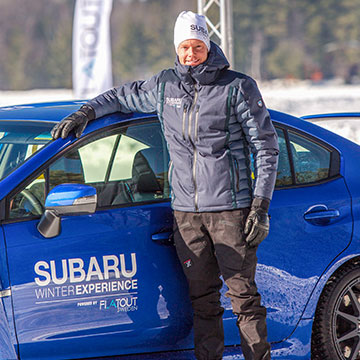My driving partner, Lyndon Shirley, and I rolled the 2018 BRZ to the flags in our first exercise of SRTUSA standout Patrik Sandell’s brilliant Subaru Winter Experience, and I’ll admit to being pretty nervous. Not because I was concerned about the rear-drive sport coupe on the ice, but because I didn’t want to make a fool out of myself stalling the six-speed at the start.

It’s one thing to fishtail around in four inches of fresh powder in an empty parking lot by yourself. It’s another to have 25 people watch you do it.
That’s the genius of Patrik Sandell, though. Gathered on a frozen lake at a resort in northern Wisconsin, everyone in our group was on a pretty equal footing. Some of us were better than others. Some of us weren’t up to the rigors of driving a manual transmission. But we were all going to be doing things over the course of the day-long winter driving school that booted us out of our comfort zones.

The cars represented the range of Subaru performance. The rear-drive BRZ allowed us to hoon around without the full-on turbocharged power of the WRX, or the blistering performance of the WRX STI. But before the instruction was over, we’d have ample seat time in all the cars.
I’ve done driving classes before, but the unique thing about this experience is that the instructors aren’t in the car with you. The class is run by Sandell’s FlatOut Sweden, which hosts events like this in Sandell’s native Åre, at a ski resort in Northern Europe.
For this American incarnation of the school, Sandell enlisted the support of Nate Tennis and Michelle Miller from DirtFish Rally School in Washington.


Instead of riding along, Miller and Tennis would talk us through what they expected in every exercise; then they’d demonstrate it so we could see what it should look like. Then, with a driving partner riding shotgun, we performed the exercises at ever-increasing speed, with just a radio in the car to communicate with the instructors.
For the passenger, it allowed a look at how the driver succeeded and struggled, giving them some things to think about before their turn in the hot seat.
The first exercise was a braking test, to show how Subaru ABS and Vehicle Stability Control (VSC) work under the most extreme conditions. All the cars we drove were equipped with serious ice-biting tires – Swedish Lappi winter rally tires, bristling with heavy-duty metal studs. Even then, it didn’t take much for the tires to lose traction on the surface of the ice.

In the braking test, we accelerated to 30 mph, got on the brakes as hard as possible and steered around a “moose,” a coned-off area dead ahead. We attempted the maneuver with both right and left steering inputs, then increased the speed to about 50 mph. Getting this exercise out of the way early quickly familiarized our group with a lot of lateral movement on the ice.
From there, we hit a slalom course, and really had a chance to experience the different VSC modes. In Normal mode, there’s hardly any wheelspin as the Traction Control (TRC) comes in quickly. (See chart below)
BRZ and VSC: Get the most out of VSC in winter conditions.

| Mode | Main Use | How to Activate | Effect on Driving | VSC | TRC | Indicator Lights |
|---|---|---|---|---|---|---|
| Normal | Daily driving | Default mode | Wheelspin limited, TRC is on. Under/oversteer instantly corrected by VSC. | Fully on | Fully on | N/A |
| Track Mode | Track driving | Press Track Mode button | Allows extra wheelspin before intervention. Still corrects under/oversteer, but allows more than Normal mode. | Reduced sensitivity | Reduced sensitivity | 1,2 |
| TRC Off | Limited conditions where wheelspin is required | Press the TRC switch | Disables TRC so you can spin the wheels, such as starting in deep snow. VSC is still enabled. TRC engages if you exceed 35 mph, or if VSC engages. | Fully on | Off | 2,3 |
| TRC Off + Track Mode | Getting the car unbogged | Press the TRC switch and then the VSC switch | Same as Track Mode, but allows full wheelspin. TRC engages if you exceed 35 mph, or if VSC engages. | Reduced sensitivity | Off | 1,2,3 |
| VSC and TRC off | Performance driving, drifting | Hold down the TRC switch for three seconds | VSC and TRC completely bypassed. | Off | Off | 1,3 |
With the short drifts allowed by a slalom behind us, we headed out into the several rally courses, each designed to quickly build confidence. This was where I learned more about all-wheel drive cars than I ever had before.
As a kid from New England, I had an adult lifetime of experience pitching rear-drive cars sideways, so I felt right at home in the BRZ. But making an all-wheel drive car drift was a skill I just didn’t have. I asked Michelle Miller to run us around one lap to explain how it differed from rear-drive, and she nailed it. The missing link for me was braking. In the BRZ, I was doing half of my steering with the rear wheels, counter-steering to full lock when the car oversteered. With the WRX and STI, the brakes are key. A little bit of brake transfers the weight to the front wheels, giving them the bite they need to turn, and the car sort of pivots on its axis. Want to open the line a little? Apply throttle and the weight transfers to the rear wheels, pushing the car to the outside of the turn.


Steering input matters, obviously, but it’s more about understanding the balance of a WRX or WRX STI. By the time we hit our second course, we were putting skills together in tight sections, and then wringing the car out on long, right and left sweeping turns across the ice.
Just before we reached the end of the course, we had the ultimate test: a tight hairpin bookended by long straights. Learning how to execute the pendulum turn – the Scandinavian Flick – was why I boarded a plane to Wisconsin in February.
Approaching the tight left-hander, I turned to the right – away from the hairpin – and gave the brakes a quick stab. Then I turned left – toward the corner – and gave it the gas to transfer weight to the rear wheels, and snap, I pivoted hard to the left. With the wheels straight and a little throttle, you’re on your way out of the hairpin.
What the real surprise was for me – a hardened manual transmission fan – was how much fun it was to drive the WRX with the CVT. In Intelligent mode, it’s a sedate daily driver, but Sport dials up the fun, and Sport # matched revs like a champ so that I could concentrate on not burying myself in a snowbank as I hung onto a drift as long as possible.
It’s an exhausting, full day of driving that will leave you wanting more. If you have the chance to go to a driving school such as this one, do it. You’ll never forget it.





